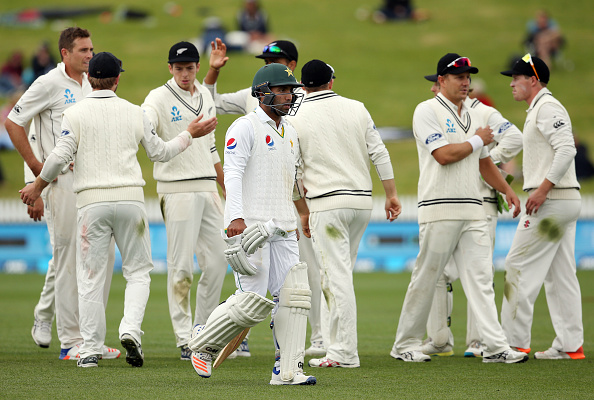
Pakistan need to be disciplined to fare well in Australia
Pakistan toured Australia for the first time in 1964. It was a one-off eight-ball-over Test match where Hanif Mohammad’s men returned home after earning a respectable draw. It was a series where batsmen from both sides scored runs on the Melbourne track.
Hanif scored a hundred followed by a ninety while Barry Shepherd, Bob Cowper, Brian Booth and Tom Vievers notched up half-centuries. Graham Mckenzie and Neil Hawk bowled well and it was Ian Chappell’s debut Test where he managed to fetch just eleven runs.
Pakistan returned to Australia in the 1972-73 season. Overall, it was a disastrous tour. The poor temperament of the Pakistan batsmen ensured a 3-0 whitewash. But the next two tours were praiseworthy enough for the visitors as the charismatic bowling displays of Imran Khan and Sarfraz Nawaz enabled them to notch-up 1-1 draws.
Also read: Australia vs Pakistan 2016: 1st Test - 5 focus areas for Pakistan
Dismal record Down Under
Since the 80s until now, the story of an Australian tour has been a sad one for the men in green. During 1989-90 and 1999-00, Imran Khan and Wasim Akram’s men set foot on Australian soil with high hopes, but on both occasions, their hopes were shattered.
Even though Pakistan’s success in limited-overs cricket is good, in Test matches, it’s a completely different story. The last time Pakistan won a Test match in Australia was twenty-one years ago and overall, they have won just four Test matches Down Under which is pretty dismal.
Slump against New Zealand
Misbah-ul-Haq’s men earned the status of being the best Test team in the world after winning the final Test at the Oval, but their stay at the top didn’t last long after being humiliated against New Zealand who had just returned home after completing a torrid tour of India. Pakistan had not lost a Test series in New Zealand since 1984-85, but that record was breached last month in a very humiliating fashion.
The Test series against New Zealand was supposed to be a great opportunity to boost the confidence for the tough assignment against the Kangaroos. Sadly, the Pakistani batting failed to act according to the situation and surrendered meekly which was quite unexpected.

The approach of the Pakistani batsmen in New Zealand was very negative. They decided to switch to an ultra-defensive mode and in each session, the scoring rate was so sluggish, it automatically created huge pressure on the remaining batsmen and when they tried to come out of their shells, they all succumbed. In the second Test, Pakistan lost ten wickets for 99 runs and it all happened due to one of the worst displays of ultra-defensive batting.
Keys to success
The wait-and-watch game or the ultra-defensive mode won’t fetch runs consistently in Australia. To succeed as a batsman on tracks like Brisbane or Melbourne, a batsman should be able to create scoring opportunities. There are very few loose balls that show up, and hence, it is very important to utilise the proper technique to score runs against those balls that are slightly over-pitched or short.
If one notices Pakistan’s most successful tours in Australia during the 1976-77 and 1978-79 seasons, it was the positive batting of Majid Khan and Asif Iqbal which set the tone for the rest of the sessions and gave Imran and Sarfraz the boost to go for the kill.
Pakistan’s success in Australia will depend on how they bat and it will be the duty of Younis Khan and Misbah to show this young team how to withstand the pace and bounce hard f the Australian wickets.
Pakistan’s bowling line-up has always been good, but seldom have they created an impact Down Under, except for Imran and Sarfraz. Wasim Akram, Waqar Younis and Shoaib Akhtar were inconsistent performers – the five-wicket hauls came, but they were few and far between and hardly mattered in the long run.

Bowling in Australia in Test matches is not just about pace and aggression, but discipline. A fast bowler must be able to bowl six balls out of six at a deceptive pace on a length short enough to prevent the batsmen from playing forward, yet full enough to gain late movement through the air and off the wicket and by swing, curve, angle or cut find the edge of the bat.
Also read: 5 memorable Test performances by a Pakistani player in Australia
Mohammad Amir, Wahab Riaz, Rahat Ali, Sohail Khan and Imran Khan junior are good pace bowlers, but they are not consistent. The best way to handle such pacers is by using them in short spells and rotate them smartly. Misbah must bear in mind, his strike bowler is Yasir Shah, who can be extremely useful on Australian pitches like Mushtaq Ahmed and thus, he needs to fit the right pacer to bowl in tandem with him so that the pressure is never released.
Again, Pakistan cannot afford to drop catches or exhibit sloppy fielding. Amir will definitely give Pakistan the opportunity with the new ball, but if the slip cordon fails to grasp the chances, it won’t help the side at all.

Misbah sounded confident about doing well in Australia, but deep down he is well aware of how tough it will be to fulfil his dreams as, after the defeat against South Africa, Steve Smith and his men will be looking to bounce back and pummel the opposition into submission. They showed their intentions against New Zealand in the Chappell-Hadlee trophy and they look to be charged up and ready to go against a country that has a dismal record in Australia.
Surely Misbah’s task won’t be easy and to win in Australia, he needs to constantly attack.
